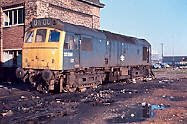.
In the early 19th century there was an energy revolution taking place in the manufacturing industry. The discovery and exploitation of coal enabled innovative engineers to develop the mighty steam engine. This replaced water as the main source of power in their factory’s. In turn the coming of the railways created a revolution in transportation. With industry crying out for coal,  mining and the railways developed side by side. Most towns had their own gasworks with coal delivered by rail to their own private sidings and the domestic use of coal for heating and cooking developed rapidly. This insatiable demand and the enormous growth in coal output led to the rapid and continued expansion of Toton Sidings. By the time coal production reached its peak Toton had grown into the largest marshalling yard in Europe and the third largest in the world. It had become a Railway Empire. In the 1950s with mechanisation of the up side completed the yards were handling over a million wagons a year. The next fifteen years would be Toton’s golden years. By the mid sixties the Railways had shelved any plans for future marshalling yards. The introduction of tops and MGR wagons meant that block trains could be run from the pit
mining and the railways developed side by side. Most towns had their own gasworks with coal delivered by rail to their own private sidings and the domestic use of coal for heating and cooking developed rapidly. This insatiable demand and the enormous growth in coal output led to the rapid and continued expansion of Toton Sidings. By the time coal production reached its peak Toton had grown into the largest marshalling yard in Europe and the third largest in the world. It had become a Railway Empire. In the 1950s with mechanisation of the up side completed the yards were handling over a million wagons a year. The next fifteen years would be Toton’s golden years. By the mid sixties the Railways had shelved any plans for future marshalling yards. The introduction of tops and MGR wagons meant that block trains could be run from the pit s to the power stations without being re-marshalled. The writing was on the wall and the Empire was beginning to crumble. After a hundred years rise the fall was to be far swifter. Diesel was replacing steam on the railways, gas heating was replacing coal fires and natural gas meant the end of the local gasworks. As the need for coal died so did Toton. The Down Side ceased hump shunting in 1978 followed six years later by the Up Side in 1984. The golden age of coal and steam was over and one by one the yards were closed and the rails lifted. Nine years into the new millenium and the final insult. Toton has lost its Daw Mill traffic. It has become a Ballast Depot in all but name. As for the yard, the latest plan is to shut the upside altogether and run everything out of the North Yard.
s to the power stations without being re-marshalled. The writing was on the wall and the Empire was beginning to crumble. After a hundred years rise the fall was to be far swifter. Diesel was replacing steam on the railways, gas heating was replacing coal fires and natural gas meant the end of the local gasworks. As the need for coal died so did Toton. The Down Side ceased hump shunting in 1978 followed six years later by the Up Side in 1984. The golden age of coal and steam was over and one by one the yards were closed and the rails lifted. Nine years into the new millenium and the final insult. Toton has lost its Daw Mill traffic. It has become a Ballast Depot in all but name. As for the yard, the latest plan is to shut the upside altogether and run everything out of the North Yard.
 mining and the railways developed side by side. Most towns had their own gasworks with coal delivered by rail to their own private sidings and the domestic use of coal for heating and cooking developed rapidly. This insatiable demand and the enormous growth in coal output led to the rapid and continued expansion of Toton Sidings. By the time coal production reached its peak Toton had grown into the largest marshalling yard in Europe and the third largest in the world. It had become a Railway Empire. In the 1950s with mechanisation of the up side completed the yards were handling over a million wagons a year. The next fifteen years would be Toton’s golden years. By the mid sixties the Railways had shelved any plans for future marshalling yards. The introduction of tops and MGR wagons meant that block trains could be run from the pit
mining and the railways developed side by side. Most towns had their own gasworks with coal delivered by rail to their own private sidings and the domestic use of coal for heating and cooking developed rapidly. This insatiable demand and the enormous growth in coal output led to the rapid and continued expansion of Toton Sidings. By the time coal production reached its peak Toton had grown into the largest marshalling yard in Europe and the third largest in the world. It had become a Railway Empire. In the 1950s with mechanisation of the up side completed the yards were handling over a million wagons a year. The next fifteen years would be Toton’s golden years. By the mid sixties the Railways had shelved any plans for future marshalling yards. The introduction of tops and MGR wagons meant that block trains could be run from the pit s to the power stations without being re-marshalled. The writing was on the wall and the Empire was beginning to crumble. After a hundred years rise the fall was to be far swifter. Diesel was replacing steam on the railways, gas heating was replacing coal fires and natural gas meant the end of the local gasworks. As the need for coal died so did Toton. The Down Side ceased hump shunting in 1978 followed six years later by the Up Side in 1984. The golden age of coal and steam was over and one by one the yards were closed and the rails lifted. Nine years into the new millenium and the final insult. Toton has lost its Daw Mill traffic. It has become a Ballast Depot in all but name. As for the yard, the latest plan is to shut the upside altogether and run everything out of the North Yard.
s to the power stations without being re-marshalled. The writing was on the wall and the Empire was beginning to crumble. After a hundred years rise the fall was to be far swifter. Diesel was replacing steam on the railways, gas heating was replacing coal fires and natural gas meant the end of the local gasworks. As the need for coal died so did Toton. The Down Side ceased hump shunting in 1978 followed six years later by the Up Side in 1984. The golden age of coal and steam was over and one by one the yards were closed and the rails lifted. Nine years into the new millenium and the final insult. Toton has lost its Daw Mill traffic. It has become a Ballast Depot in all but name. As for the yard, the latest plan is to shut the upside altogether and run everything out of the North Yard.












